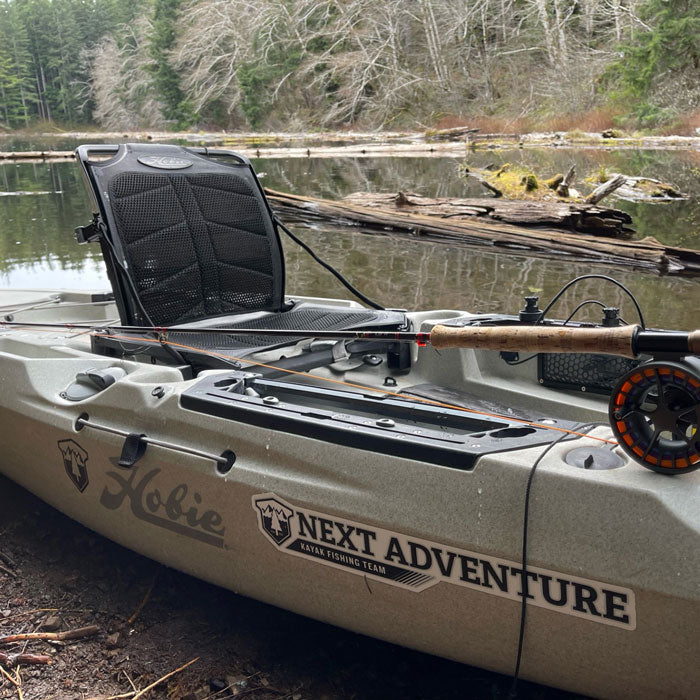
Gear Review: Hobie Mirage Outback Fishing Kayak
For the past year or so, I’ve been fortunate enough to own the venerable Hobie Mirage Outback. For over two decades, the Hobie Outback has led the pack among fishing kayaks, and after extensive testing on my end, I understand why.
The first thing to bring up about the Hobie Mirage Outback is the Mirage 180 Drive itself. The drive is unique among pedal driven kayaks in that it uses two fins (in the case of the Outback, two Turbo Fins) rather than a propellor to move the boat forwards and backwards. Admittedly, seeing it on land for the first time doesn’t inspire a ton of confidence, however after spending eight hours trolling non-stop for Coho Salmon at 4mph I can say the drive works.
SHOP HOBIE KAYAKS
Another nice feature of the drive are the kick-up fins, they’re designed to retract in the event you run into something. So far, I’ve done a pretty good job avoiding testing that feature but I’ve heard from plenty of other people that it does the trick and saves you plenty of money from needing to repair the drive.
 One thing I’ve found I really appreciate about the Outback is the size. At 82 pounds unloaded and 12’9” long, it’s about as large as I can physically get on top of my Forester without risking damage to a sideview mirror or a car parked a little too close.
A common concern (and justifiably so) is the seat. You’ll be sitting on this thing for hours on end, so it better be comfortable. While it’s not my couch, it’s about as good as a kayak seat can get. There are vertical adjustments in the front and rear of the seat, and adjustable lumbar support as well. The mesh on the seat has turned out to be quite durable while still being breathable.
One thing I’ve found I really appreciate about the Outback is the size. At 82 pounds unloaded and 12’9” long, it’s about as large as I can physically get on top of my Forester without risking damage to a sideview mirror or a car parked a little too close.
A common concern (and justifiably so) is the seat. You’ll be sitting on this thing for hours on end, so it better be comfortable. While it’s not my couch, it’s about as good as a kayak seat can get. There are vertical adjustments in the front and rear of the seat, and adjustable lumbar support as well. The mesh on the seat has turned out to be quite durable while still being breathable.
 The Outback has plenty of space to mount nearly every accessory you can think of. In the front of the cockpit there are two gear tracks and two H-Rails (with gear tracks cut into the top). I’ve found the side-to-side gear track and H-Rail combo to be a great way to mount my fish finder and my rod holder in the same general area. The H-Rail serves as a mounting spot for some of the sturdiest mounts out there. In the past, I’ve had gear tracks flex when a large salmon strikes, but the H-Rail hasn’t budged (maybe I need to catch bigger fish). In addition to the gear mounts, the kayak comes with several through hull ports installed, which turns a normally nerve-wracking afternoon of fish finder installation to a relatively quick process.
On the water, it handles exactly how you would hope. The rudder is placed farther forward in the hull than many fishing kayaks, which keeps the turning radius down to an absolute minimum. The steering is responsive if not touchy. I really appreciate having rudder control on both sides of the kayak, it lets me keep one hand warm while the other is controlling the boat. One thing to note about the steering, it’s all connected by spectra cord, which can stretch a little bit over time, causing the handling to be somewhat sloppy. It’s an easy fix, but it is something to be aware of.
The Outback has plenty of space to mount nearly every accessory you can think of. In the front of the cockpit there are two gear tracks and two H-Rails (with gear tracks cut into the top). I’ve found the side-to-side gear track and H-Rail combo to be a great way to mount my fish finder and my rod holder in the same general area. The H-Rail serves as a mounting spot for some of the sturdiest mounts out there. In the past, I’ve had gear tracks flex when a large salmon strikes, but the H-Rail hasn’t budged (maybe I need to catch bigger fish). In addition to the gear mounts, the kayak comes with several through hull ports installed, which turns a normally nerve-wracking afternoon of fish finder installation to a relatively quick process.
On the water, it handles exactly how you would hope. The rudder is placed farther forward in the hull than many fishing kayaks, which keeps the turning radius down to an absolute minimum. The steering is responsive if not touchy. I really appreciate having rudder control on both sides of the kayak, it lets me keep one hand warm while the other is controlling the boat. One thing to note about the steering, it’s all connected by spectra cord, which can stretch a little bit over time, causing the handling to be somewhat sloppy. It’s an easy fix, but it is something to be aware of.
 While I generally fish seated, the Outback is plenty stable for me to stand up and fish if I chose to. I’ve surf-launched the kayak quite a few times and it handled the surf with ease, maybe a little on the wet side, but nothing extreme. I will say the hull of the Outback does tend to catch waves more easily than other kayaks I’ve taken into the ocean.
The main drawback (or a plus depending on how you see it) is that it’s made to do it all. If I were strictly a bass fisherman, I’d probably go with a Hobie Pro Angler. When I go out ocean trolling for salmon, I’m always a little envious of my friend and his Hobie Revolution 13, since it’s a little faster. Whatever I decide to fish and what I decide to fish for, I’m confident my Hobie Outback can handle it, and that counts for a lot!
While I generally fish seated, the Outback is plenty stable for me to stand up and fish if I chose to. I’ve surf-launched the kayak quite a few times and it handled the surf with ease, maybe a little on the wet side, but nothing extreme. I will say the hull of the Outback does tend to catch waves more easily than other kayaks I’ve taken into the ocean.
The main drawback (or a plus depending on how you see it) is that it’s made to do it all. If I were strictly a bass fisherman, I’d probably go with a Hobie Pro Angler. When I go out ocean trolling for salmon, I’m always a little envious of my friend and his Hobie Revolution 13, since it’s a little faster. Whatever I decide to fish and what I decide to fish for, I’m confident my Hobie Outback can handle it, and that counts for a lot!

 One thing I’ve found I really appreciate about the Outback is the size. At 82 pounds unloaded and 12’9” long, it’s about as large as I can physically get on top of my Forester without risking damage to a sideview mirror or a car parked a little too close.
A common concern (and justifiably so) is the seat. You’ll be sitting on this thing for hours on end, so it better be comfortable. While it’s not my couch, it’s about as good as a kayak seat can get. There are vertical adjustments in the front and rear of the seat, and adjustable lumbar support as well. The mesh on the seat has turned out to be quite durable while still being breathable.
One thing I’ve found I really appreciate about the Outback is the size. At 82 pounds unloaded and 12’9” long, it’s about as large as I can physically get on top of my Forester without risking damage to a sideview mirror or a car parked a little too close.
A common concern (and justifiably so) is the seat. You’ll be sitting on this thing for hours on end, so it better be comfortable. While it’s not my couch, it’s about as good as a kayak seat can get. There are vertical adjustments in the front and rear of the seat, and adjustable lumbar support as well. The mesh on the seat has turned out to be quite durable while still being breathable.
 The Outback has plenty of space to mount nearly every accessory you can think of. In the front of the cockpit there are two gear tracks and two H-Rails (with gear tracks cut into the top). I’ve found the side-to-side gear track and H-Rail combo to be a great way to mount my fish finder and my rod holder in the same general area. The H-Rail serves as a mounting spot for some of the sturdiest mounts out there. In the past, I’ve had gear tracks flex when a large salmon strikes, but the H-Rail hasn’t budged (maybe I need to catch bigger fish). In addition to the gear mounts, the kayak comes with several through hull ports installed, which turns a normally nerve-wracking afternoon of fish finder installation to a relatively quick process.
On the water, it handles exactly how you would hope. The rudder is placed farther forward in the hull than many fishing kayaks, which keeps the turning radius down to an absolute minimum. The steering is responsive if not touchy. I really appreciate having rudder control on both sides of the kayak, it lets me keep one hand warm while the other is controlling the boat. One thing to note about the steering, it’s all connected by spectra cord, which can stretch a little bit over time, causing the handling to be somewhat sloppy. It’s an easy fix, but it is something to be aware of.
The Outback has plenty of space to mount nearly every accessory you can think of. In the front of the cockpit there are two gear tracks and two H-Rails (with gear tracks cut into the top). I’ve found the side-to-side gear track and H-Rail combo to be a great way to mount my fish finder and my rod holder in the same general area. The H-Rail serves as a mounting spot for some of the sturdiest mounts out there. In the past, I’ve had gear tracks flex when a large salmon strikes, but the H-Rail hasn’t budged (maybe I need to catch bigger fish). In addition to the gear mounts, the kayak comes with several through hull ports installed, which turns a normally nerve-wracking afternoon of fish finder installation to a relatively quick process.
On the water, it handles exactly how you would hope. The rudder is placed farther forward in the hull than many fishing kayaks, which keeps the turning radius down to an absolute minimum. The steering is responsive if not touchy. I really appreciate having rudder control on both sides of the kayak, it lets me keep one hand warm while the other is controlling the boat. One thing to note about the steering, it’s all connected by spectra cord, which can stretch a little bit over time, causing the handling to be somewhat sloppy. It’s an easy fix, but it is something to be aware of.
 While I generally fish seated, the Outback is plenty stable for me to stand up and fish if I chose to. I’ve surf-launched the kayak quite a few times and it handled the surf with ease, maybe a little on the wet side, but nothing extreme. I will say the hull of the Outback does tend to catch waves more easily than other kayaks I’ve taken into the ocean.
The main drawback (or a plus depending on how you see it) is that it’s made to do it all. If I were strictly a bass fisherman, I’d probably go with a Hobie Pro Angler. When I go out ocean trolling for salmon, I’m always a little envious of my friend and his Hobie Revolution 13, since it’s a little faster. Whatever I decide to fish and what I decide to fish for, I’m confident my Hobie Outback can handle it, and that counts for a lot!
While I generally fish seated, the Outback is plenty stable for me to stand up and fish if I chose to. I’ve surf-launched the kayak quite a few times and it handled the surf with ease, maybe a little on the wet side, but nothing extreme. I will say the hull of the Outback does tend to catch waves more easily than other kayaks I’ve taken into the ocean.
The main drawback (or a plus depending on how you see it) is that it’s made to do it all. If I were strictly a bass fisherman, I’d probably go with a Hobie Pro Angler. When I go out ocean trolling for salmon, I’m always a little envious of my friend and his Hobie Revolution 13, since it’s a little faster. Whatever I decide to fish and what I decide to fish for, I’m confident my Hobie Outback can handle it, and that counts for a lot!


